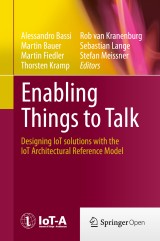Details

Enabling Things to Talk
Designing IoT solutions with the IoT Architectural Reference Model|
51,16 € |
|
| Verlag: | Springer |
| Format: | |
| Veröffentl.: | 28.10.2013 |
| ISBN/EAN: | 9783642404030 |
| Sprache: | englisch |
Dieses eBook enthält ein Wasserzeichen.
Beschreibungen
<p>The Internet of Things (IoT) is an emerging network superstructure that will connect physical resources and actual users. It will support an ecosystem of smart applications and services bringing hyper-connectivity to our society by using augmented and rich interfaces. Whereas in the beginning IoT referred to the advent of barcodes and Radio Frequency Identification (RFID), which helped to automate inventory, tracking and basic identification, today IoT is characterized by a dynamic trend toward connecting smart sensors, objects, devices, data and applications. The next step will be “cognitive IoT,” facilitating object and data re-use across application domains and leveraging hyper-connectivity, interoperability solutions and semantically enriched information distribution.</p><p>The Architectural Reference Model (ARM), presented in this book by the members of the IoT-A project team driving this harmonization effort, makes it possible to connect vertically closed systems, architectures and application areas so as to create open interoperable systems and integrated environments and platforms. It constitutes a foundation from which software companies can capitalize on the benefits of developing consumer-oriented platforms including hardware, software and services.</p><p>The material is structured in two parts. Part A introduces the general concepts developed for and applied in the ARM. It is aimed at end users who want to use IoT technologies, managers interested in understanding the opportunities generated by these novel technologies, and system architects who are interested in an overview of the underlying basic models. It also includes several case studies to illustrate how the ARM has been used in real-life scenarios. Part B then addresses the topic at a more detailed technical level and is targeted at readers with a more scientific or technical background. It provides in-depth guidance on the ARM, including a detailed description of a process for generating concrete architectures, as well as reference manuals with guidelines on how to use the various models and perspectives presented to create a concrete architecture. Furthermore, best practices and tips on how system engineers can use the ARM to develop specific IoT architectures for dedicated IoT solutions are illustrated and exemplified in reverse mapping exercises of existing standards and platforms.</p>
Introduction to the Internet of Things.- The Need for a Common Ground for the IoT — The History and Reasoning Behind the IoT — A Project.- The IoT Architectural Reference Model as Enabler.- IoT in Practice: Examples — IoT in Logistics and Health.- IoT — A Guidance to the ARM.- A Process to Generate Concrete Architectures.- IoT Reference Model.- IoT Reference Architecture.- The IoT ARM Reference Manual.- Interactions.- Toward a Concrete Architecture.- ARM Testimonials.- Summary and Outlook.
The IoT-Architecture project (IoT-A) is the European Commission’s flagship project in the European Union’s Seventh Framework Program for Research and Development with respect to establishing an architecture for the Internet of Things. Together, the editors and contributing authors represent more than 20 large industrial companies and research institutions, including Alcatel-Lucent, IBM , Ericsson, NEC, NXP, SAP, Siemens, and the Universities of Rome “La Sapienza,” St. Gallen, Surrey, and Würzburg, as well as CEA, CFRG, FhG, and VTT.
<p>The Internet of Things (IoT) is an emerging network superstructure that will connect physical resources and actual users. It will support an ecosystem of smart applications and services bringing hyper-connectivity to our society by using augmented and rich interfaces. Whereas in the beginning IoT referred to the advent of barcodes and Radio Frequency Identification (RFID), which helped to automate inventory, tracking and basic identification, today IoT is characterized by a dynamic trend toward connecting smart sensors, objects, devices, data and applications. The next step will be “cognitive IoT,” facilitating object and data re-use across application domains and leveraging hyper-connectivity, interoperability solutions and semantically enriched information distribution.</p><p>The Architectural Reference Model (ARM), presented in this book by the members of the IoT-A project team driving this harmonization effort, makes it possible to connect vertically closed systems, architectures and application areas so as to create open interoperable systems and integrated environments and platforms. It constitutes a foundation from which software companies can capitalize on the benefits of developing consumer-oriented platforms including hardware, software and services. </p><p>The material is structured in two parts. Part A introduces the general concepts developed for and applied in the ARM. It is aimed at end users who want to use IoT technologies, managers interested in understanding the opportunities generated by these novel technologies, and system architects who are interested in an overview of the underlying basic models. It also includes several case studies to illustrate how the ARM has been used in real-life scenarios. Part B then addresses the topic at a more detailed technical level and is targeted at readers with a more scientific or technical background. It provides in-depth guidance on the ARM, including a detailed description of a process for generating concrete architectures, as well as reference manuals with guidelines on how to use the various models and perspectives presented to create a concrete architecture. Furthermore, best practices and tips on how system engineers can use the ARM to develop specific IoT architectures for dedicated IoT solutions are illustrated and exemplified in reverse mapping exercises of existing standards and platforms.</p>
First comprehensive overview of the European Architecture Reference Model (ARM) for the Internet of Things Includes both a reference manual and numerous best practices and tips for implementing the ARM Illustrates ARM implementations on the basis of several industrial case studies Written in cooperation by leading software and solution providers (Alcatel-Lucent, IBM , Ericsson, NEC, NXP, SAP, Siemens) and top-level research institutions Includes supplementary material: sn.pub/extras
Diese Produkte könnten Sie auch interessieren:

Mixed-Signal Layout Generation Concepts

von: Chieh Lin, Arthur H.M. van Roermund, Domine Leenaerts

96,29 €

System-Level Design Techniques for Energy-Efficient Embedded Systems

von: Marcus T. Schmitz, Bashir M. Al-Hashimi, Petru Eles

96,29 €














